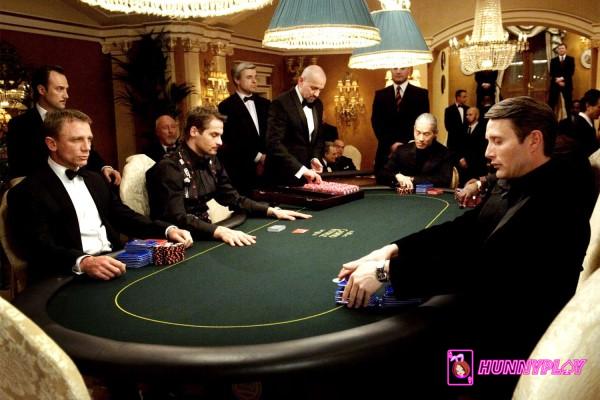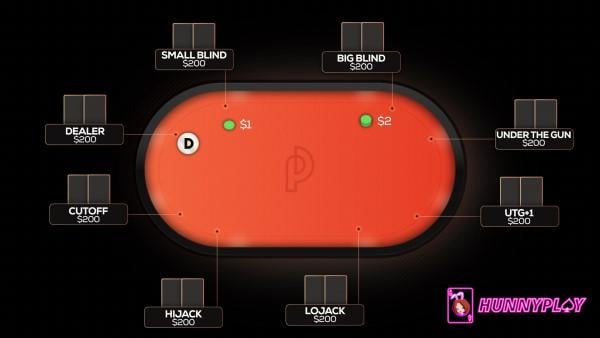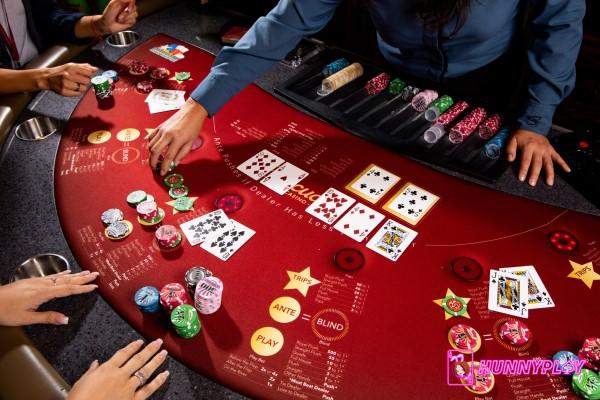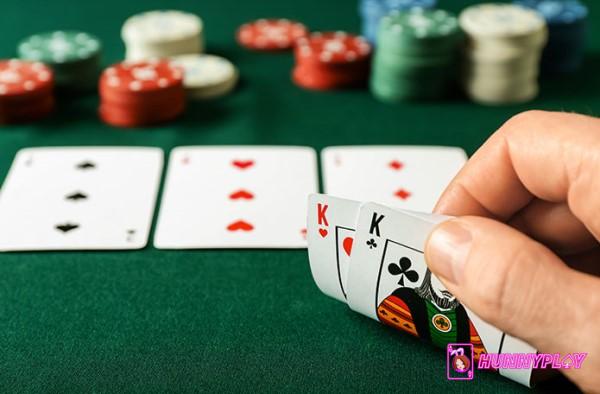In Poker, your seat isn’t just a place—it’s a strategy. Every position at the table shapes your moves, from when to bet to how to bluff. This guide from HunnyPlay will dive into the nuances of Poker positions, offering valuable tips to help you turn your Poker positions into an advantage and elevate your game to new heights.
What does Poker position mean?
At most Poker tables, you will see anywhere from two to nine players sitting in different positions, depending on the format of the game. The term “Poker position” is defined by two factors:
- Seating position: This refers to the position a player sits at the table.
- Order of action: This describes which player acts last in a hand. The player who acts last after the cards are dealt is “in position” (IP), while the player who acts first is “out of position” (OOP).
Poker positions are fundamental to being a successful player. Mastering these concepts of Poker position is crucial to developing an effective strategy at the table.

Poker positions are fundamental to becoming a successful player. (Internet)
Understanding different positions in Poker
The Under The Gun (UTG)
The UTG position is considered the most challenging in the preflop stage because the player here acts first, with the least information about the other players’ actions.
This lack of insight forces them to rely heavily on the strength of their hand, resulting in a much tighter range of starting hands compared to other positions.
The Under The Gun + 1 (UTG+1)
The UTG+1 position doesn’t offer much of an advantage compared to being Under the Gun. You only get to observe the action of one player before making your decision while still facing seven other players.
Although this position allows for a slightly wider range of opening hands, caution is still key, as you need to play carefully given the number of remaining opponents.
The Under The Gun + 2 (UTG+2)
The UTG+2 position, along with the two seats before it, is classified as an early position at a 9-handed table.
These Poker positionss are particularly challenging to play preflop because players in these positions have limited information about their opponents’ hands.
Additionally, after the flop, they are often out of position, making strategic decisions even tougher. As a result, it’s wise to stick to a tight range of about 15% of starting hands to maintain an advantage.
The Lowjack
The Lowjack in a 9-max Poker game is comparable to the UTG position in a 6-max game. In both cases, the same number of players are left to act after you.
As a result, the range of hands players can comfortably open with from this Poker positions remains relatively narrow.
While slightly more flexible than earlier positions, it’s still important to play cautiously to avoid running into stronger hands later in the betting round.
The Hijack
The Hijack position offers a slight advantage over earlier seats. Here, you get the benefit of observing the actions of early-position players before making your own decision.
Additionally, with fewer opponents left to act after you, the pressure eases, allowing you to expand your opening hand range.
This is a great Poker positions to start incorporating more off-suit hands with blockers into your strategy, giving you more flexibility while still maintaining a cautious approach.
The Cutoff
The Cutoff is where the game starts to get exciting. From this position, you can begin stealing blinds more aggressively, as only one player remains in position after you—the Button.
If you can make the Button fold, you’ll be in strong Poker positions, controlling the action against the blinds for the rest of the hand. This strategic advantage gives you greater control, allowing you to dictate the pace of play.
The Button
The Button is the most powerful seat at the Poker table. From this position, you have the advantage of seeing how the first three Poker positions act, allowing you to adjust your strategy accordingly.
Even more importantly, you’re the last to act on each street after the flop, giving you control over the flow of the hand.
This unique advantage allows the Button to play the widest range of hands compared to any other position, making it a key spot for aggressive and strategic play.
The Small Blind
While the Small Blind has the advantage of seeing other players’ actions before deciding preflop, this benefit is outweighed by a key disadvantage: after the flop, the SB is the first to act on every street, and the Big Blind still has a turn to act.
This makes the Small Blind’s range much narrower compared to the Button. Additionally, having to place chips into the pot before even seeing your cards puts the SB at a significant disadvantage, further complicating the Poker positions’s strategy.
The Big Blind
The Big Blind is considered the toughest position in poker. Being forced to post the full big blind before seeing your cards puts you at a disadvantage from the start.
On top of that, you’re the second player to act after the flop, leaving you out of position for most of the hand.
While you’ll need to defend a wide range of hands, especially when antes are in play, this rarely compensates for the initial loss of placing a large blind without seeing your hand.
In summary, Poker positions critically impact your chances of winning. To ensure fairness, these positions rotate clockwise after each hand, giving all players an equal opportunity at different positions.

Poker table positions diagram (Source: Pokercode)
Why is position important in Poker?
Playing in position offers numerous advantages, and the most important are outlined below:
More free cards
Having a favorable Poker position allows you to control the flow of the game, especially when playing drawing hands.
If you’re in position and your opponent checks, you have the option to check behind and take a “free card” without having to pay.
For instance, if you hold suited connectors like 8♣ 7♣ on a Q♣ 9♦ 2♣ flop and your opponent checks, you can check as well to see the next community card without betting.
In contrast, if you were out of position and checked, your opponent could bet, forcing you to pay to continue.
This ability to see additional cards without investing more chips is a significant strategic advantage, especially when you’re looking to complete a draw.
Being in position often translates to saving chips and gaining information, which is why position is such a critical factor in Poker.
Pot control
Acting last in a Poker hand gives you significant control over the pot size.
If you prefer a smaller pot, you can check behind when your opponent checks or simply call if they bet, closing the action. On the other hand, if you want to build a larger pot, you can choose to bet or raise when it’s your turn.
However, when out of Poker positions, you lose this control. You can’t guarantee a free card by checking, nor can you control the size of the pot as effectively when you bet. This lack of control can lead to more challenging decisions and less favorable outcomes.

Acting last in a Poker hand gives you significant control over the pot size. (Source: Internet)
More bluffing opportunities
Having position over your opponent is a significant advantage, often compensating for a weaker hand. When you act last, you can leverage the information gained to represent a stronger hand, making bluffing more effective.
For instance, if you raise from the Button and the Big Blind calls, then checks on an A♣ K♦ 6♥ flop, you can bet and likely force a fold if they don’t hold an Ace, King, or Six.
Whether you hold A♦ 10♦, Q♣ 6♣, or even 7♦ 2♣, your positional advantage allows you to bluff successfully, winning the hand based on strategy rather than card strength.
Calculating pot odds
When calculating pot odds, your position in the hand is crucial. Imagine you’re in a four-way pot holding K♣ 10♣ and the flop is Q♦ J♦ 5♣. The first player bets 500 into a 1,500 pot, and you’re second to act with an open-ended straight draw.
If you were last to act, you’d know your exact pot odds—trying to win 2,000 by calling 500 gives you 4-to-1 odds.
However, with players still to act behind you, this calculation becomes uncertain. They could either call, improving your odds, or raise, making it more expensive to stay in the hand.
Being in Poker positions allows you to make more accurate decisions, knowing precisely what your pot odds are before committing your chips.

Being in the right Poker position enables you to make more precise and informed decisions. (Source: Internet)
Knowing your opponent’s action
The greatest advantage of having Poker positions is the ability to observe your opponent’s actions before making your own decision.
This insight allows you to gauge their level of interest in the board—typically, a check suggests hesitation, while a bet indicates engagement.
Although opponents may try to deceive you, having position enables you to use their actions as a key factor in your strategy.
This added layer of information is invaluable, as it significantly influences how you play each street, enhancing your overall decision-making.
Poker positions: FAQs
Q: What position is the Lojack?
A: The Lojack is the seat two positions to the right of the dealer, after the Hijack and Cutoff. The players to the dealer’s left are in the Small Blind, Big Blind, and Under the Gun positions.
Q: Which position bets first in Poker?
A: The player to the left of the dealer, typically the Small Blind, acts first, with the action proceeding clockwise.
Q: What are the middle Poker positions?
A: In a nine-handed Texas Hold’em game, the fourth, fifth, and sixth players to act after the blinds are in Middle Position (MP).
Q: What is the best seat position in Poker?
A: The Button, also known as the Dealer, is the most advantageous position as it allows you to act last in each betting round after the flop. This position provides the best opportunity to observe opponents before making your decision.

The Button (a.k.a. the Dealer) is the best seat position in Poker. (Source: Internet)
Conclusion
Understanding Poker positions is key to improving your game and increasing your chances of success. Playing with position on your opponents minimizes risk and maximizes potential rewards, making it a fundamental strategy in Poker.
To master this crucial aspect of the game, practice is essential. Join HunnyPlay today to refine your skills, enjoy an immersive Poker experience, and take your game to the next level.




















